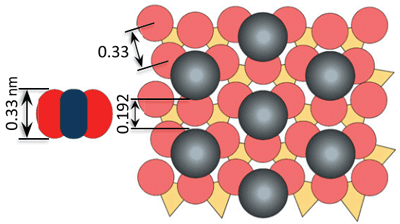
A team of Foundry scientists and users have shown that carbon dioxide can penetrate the inner layers of some non-swelling clay minerals which make up the dominant clays in the Earth’s deep subsurface. Results of the work performed at the Center for Nanoscale Controls on Geologic CO2 (NCGC) and the Molecular Foundry could help inform practices intended to help limit carbon dioxide emissions, such as carbon capture and storage (CCS) and enhanced oil recovery (EOR).
Previous studies have shown that CO2 can alter typical swelling (or expanding) phyllosilicate minerals such as smectite under the high pressures and temperatures of the deep subsurface. Less is known about the effects of CO2 on non-swelling phyllosilicates illite and muscovite, despite them being the dominant clay minerals in deep subsurface shales and mudstones.
There is the assumption that CO2 cannot penetrate layers of minerals that do not expand. However, this assumption may lead scientists to underestimate the amount of carbon storage capacity available within the deep subsurface. The researchers chose to conduct their experiments on the two similar clay minerals muscovite and illite using muscovite, because of the ability to extract it in large, smooth sheets.
In their study, the researchers subjected single muscovite crystals to incubation with supercritical CO2 (scCO2); then characterized the reacted samples using combined atomic force microscopy (AFM), X-ray photoelectron spectroscopy, X-ray diffraction, and off-gassing measurements. The first sign that CO2 had penetrated the muscovite sample came when after depressurization the team observed blisters on the muscovite surface, indicating gas entering the interlayers.
The scientists then confirmed the presence of CO2 using XPS technology, and later quantified the amount of CO2 present by comparing muscovite samples exposed to scCO2 with unexposed control samples to measure the amount of off-gassing of CO2 from the muscovite samples. The exposed samples yielded approximately seven times more CO2 than control samples.

